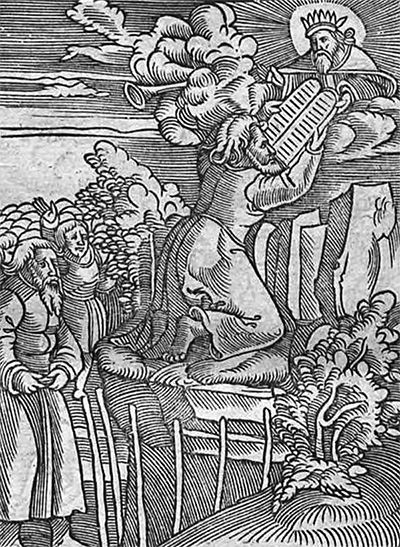Back to the Catechism: The Ten Commandments
This article reflects on the section of Luther’s Small Catechism dealing with the Ten Commandments. Read the relevant portion online in contemporary English here.
Why the Law Matters
by Edward G. Kettner

Moses receives the Ten Commandments. Woodcut from the 1558 edition of Luther’s Small Catechism.
Not long after Luther rediscovered the Gospel of free grace, he realized how terribly ignorant both the people and the clergy were of the basics of the Christian faith. Beginning already in 1518, Luther preached frequently on the basics of faith. After conducting a visitation of congregations in Saxony in 1527 and 1528, Luther lamented this lack of knowledge and determined to provide a means by which people could be educated in the faith and in the Christian life. Consequently, he wrote the catechisms to explain the content of the faith and a pattern for living out one’s faith in the world in simple form—one that could be used by heads of household as well as by clergy and school teachers.
The idea of a catechism, or a handbook to the Christian faith, was not something new. Instruction in the Creed and Lord’s Prayer, and later also the Ten Commandments, had been common in the Middle Ages, though such instruction had fallen into disuse. Prayer books had also been common, but they tended to be very moralistic rather than Gospel-centered.
In his catechisms, Luther began his teaching with the Ten Commandments, to show the student what a person should do and leave undone in one’s life, showing both what God forbids and desires, and how one continually falls short of doing God’s will. The Creed then follows, providing God’s answer and remedy for our shortcomings—namely, God’s work for us in Christ. After this comes the Lord’s Prayer, which teaches Christians to lay hold of the promises of God. Finally come the Sacraments, the means by which God provides his grace to us to create and sustain faith.
When we look at the law of God, we see that it functions for us in three ways: first, as a curb, or a leash, restraining us from external wrongdoing by fear of punishment and thus keeping order in the world; second, as a mirror, showing us our sin and our inbred inclination toward rebellion against God; and third, as a rule, or guide, showing us what God desires us to do for the sake of service to Him (the “first table” of the law) and to our neighbor (the “second table”). As Luther lays out the law in the catechism, all three of these functions are in place.
When we look at the law of God, we see that it functions in three ways: first, as a curb, restraining us from external wrongdoing by fear of punishment; second, as a mirror, showing us our sin; and third, as a rule, showing us what God desires us to do for the sake of service to Him and to our neighbor.
Since the catechism is designed to teach Christians, Luther begins his explanations of each of the commandments with the words “We should fear and love God.” The first commandment shows that God comes first, and that obedience of the others follow when the first is kept. “We should fear and love God so that…” shows that our avoidance of sinful behavior and performance of God-pleasing works come from faith. The word “we” indicates that as partakers of a common humanity, rebels who are nevertheless redeemed and loved by God, these commandments apply to everyone. Luther notes that “fear of God” includes fearing His wrath, but for the Christian this fear is not to be understood as the type of fear that a slave has for his master. Instead, it is rather the healthy respect that a child has for one’s parent—a respect that recognizes that disobedience will result in discipline and correction.
Luther explains clearly that the law itself is good. The problem lies in our disobedience. In his suggestions for devotions in the morning, after praying the morning prayer Luther suggests going to one’s daily tasks “singing a hymn to the Ten Commandments” or some other such hymn appropriate to one’s devotion. (Luther’s own hymn on the Ten Commandments can be found in hymn 581 of the Lutheran Service Book.) Then at night, per Luther’s instruction, we pray for and receive God’s forgiveness, and can fall asleep with a clear conscience.
The law of God is good and wise. As Christians, we desire to act in accord with this law, though we daily fall short in doing so. By daily repentance we are assured that we remain God’s children, trusting His promise to forgive us. Thanks be to God for His instruction to us, and for His forgiveness in Christ!
———————
Rev. Dr. Edward G. Kettner is Professor Emeritus of Systematic Theology at Concordia Lutheran Seminary (Edmonton).
This article is the second in a series exploring the six chief parts of Luther’s Small Catechism. See them all (as they are published) here.





